Astoria |
||||||||||||||||||||||||||||||||||||||||||||||
|
|
||||||||||||||||||||||||||||||||||||||||||||||
Crocheted top with round yoke, lace pattern, crocheted top down in DROPS Paris. Size: S - XXXL.
DROPS 175-15 |
||||||||||||||||||||||||||||||||||||||||||||||
|
CROCHET INFO: At beginning of every round with double crochets replace first double crochet with 3 chain stitches. Finish round with 1 slip stitch in 3rd chain stitch. At beginning of every round with treble crochets replace first treble crochet with 4 chain stitches. Finish round with 1 slip stitch in 4th chain stitch. At beginning of every round with double treble crochets replace first double treble crochet with 5 chain stitches. Finish round with 1 slip stitch in 5th chain stitch. INCREASE TIP (evenly spaced): To calculate how to increase evenly, use the number of stitches increases are done over (e.g. 84 stitches) and divide this number by number of increases to be done (e.g. 24) = 3.5. I.e. in this example increase after alternately approx. every 3rd and 4th stitch. DECREASE TIP: Decrease 1 double crochet by working 2 double crochets together as follows: * Make 1 yarn over, insert hook in next double crochet, get yarn, make 1 yarn over, pull yarn through the 2 first loops on hook *, repeat from *-* one more time, make 1 yarn over and pull yarn through all 3 loops on hook (= 1 double crochet decreased). PATTERN: See diagrams A.1 and A.2 (A.1a and A.2a shows how rounds begin and end). Choose diagram for your size. ---------------------------------------------------------- TOP: Work in the round top down. YOKE: Begin with crochet hook 5 mm and Paris, work 100-103-109-115-121-124 chain stitches and form a ring with 1 slip stitch in first chain stitch. Insert a marker thread on the beginning of the round = mid back. Work 4 chain stitches (= 1 treble crochet) - READ CROCHET INFO, work 1 treble crochet in each of the next 3-0-0-0-0-3 chain stitches, * skip 1 chain stitch, work 1 treble crochet in each of the next 5 chain stitches *, repeat from *-* 15-16-17-18-19-19 more times = 84-86-91-96-101-104 treble crochets. Work 1 round with treble crochets and increase 24-30-29-32-31-40 treble crochets evenly - READ INCREASE TIP (evenly spaced) = 108-116-120-128-132-144 treble crochets. REMEMBER THE CROCHET GAUGE! Insert 4 marker threads in piece without working as follows: Insert 1st marker thread after 8-9-10-11-11-13 treble crochets. Insert 2nd marker thread after another 38-40-40-42- 44-46 treble crochets, 3rd marker thread is after another 16-18-20-22-22-26 treble crochets and 4th marker thread after another 38-40-40-42-44-46 treble crochets. There are now 8-9-10-11-11-13 treble crochets left until mid back. Work A.1b (choose diagram for your size). A.1a shows how round begins and ends), AT THE SAME TIME increase treble crochets evenly over the 38-40-40-42-44-46 stitches in each side. Number of stitches between the 2 markers mid front and mid back is constant (= 16-18-20-22-22-26 stitches). Increase in the different sizes as follows: Size S and M: Increase 14-17 stitches in each side on 2nd and 5th round in A.1b, then increase 16-18 stitches on 6th-8th round = 196-220 stitches. NOTE! See round marked with arrow for when yoke is done in the different sizes. Size L, XL, XXL and XXXL: Increase 14-16-18-19 stitches in each side on 2nd, 5th and 8th round in A.1b, then increase 16-16-20-21 stitches on 9th-9th-11th-11th round = 236-256-280-300 stitches. NOTE! See round marked with arrow for when yoke is done in the different sizes. Work next round in all sizes as follows: NOTE: in sizes S and XL crochet around the chain stitches instead of in the chain stitches. Work 1 treble crochet in each of the first 27-30-32-35-39-43 stitches, work 4-4-6-6-6-8 chain stitches under sleeve, skip 44-50-54-58-62-64 stitches for sleeve, work 1 treble in each of the next 54-60-64-70-78-86 stitches, work 4-4-6-6-6-8 chain stitches under sleeve, skip 44-50-54-58-62-64 stitches for sleeve, work 1 treble in each of the remaining 27-30-32-35-39-43 stitches on round. Piece measures approx. 17-18-20-21-23-25 cm / 6⅝"-7"-7⅞"-8 ¼"-9"-9 ¾" measures from neck edge and down vertically. BODY: = 116-128-140-152-168-188 stitches. NOW MEASURE THE PIECE FROM HERE! Work 1 double treble crochet in every stitch. When piece measures 5 cm / 2", increase 4-12-0-8-12-12 double treble crochets evenly = 120-140-140-160-180-200 double treble crochets. Cut the yarn. To fit the pattern symmetrically mid front and mid back on top displace beginning of round as follows: Skip the first 15-5-5-15-5-15 double treble crochets on round and fasten strand with 1 single crochet in next double treble crochet. Begin on 2nd round in diagrams and work A.2a (shows how round begins and ends), work A.2b (= 6-7-7-8-9-10 repetitions). On last round in diagram increase double crochets. To make the pattern symmetrical mid front and mid back increase the same number of double crochets in each side. Increase 20 double crochets in each side evenly between mid back and fan in pattern mid front on top. Increase 40 double crochets in total evenly in all sizes = 160-180-180-200-220-240 double crochets. Continue from 2nd round in A.2a and A.2b (= 8-9-9-10-11-12 repetitions on round). When diagrams have been worked vertically, work 2nd and 3rd round 1 more time. Piece measures approx. 62-63-65-66-68-69 cm / 24⅜"-24 ¾"-25 ½"-26"-26 ¾"-27⅛" from neck edge mid back and down. Fasten off. NECK EDGE: Begin mid back of neck and fasten strand with 1 single crochet. Work 1 single crochet in every chain stitch but work only in the chain stitches worked with double crochets = 84-86-91-96-101-104 single crochets. Fasten off. SLEEVE EDGE: Begin mid under sleeve and work 4 chain stitches (= 1 treble crochet). Work 1 treble crochet in every stitch and work 3 treble crochets around the outermost stitch in transition between yoke and body AT THE SAME TIME decrease 13-15-16-14-12-11 treble crochets evenly on round – READ DECREASE TIP = 41-45-50-56-62-67 treble crochets. Fasten off. |
||||||||||||||||||||||||||||||||||||||||||||||
Diagram explanations |
||||||||||||||||||||||||||||||||||||||||||||||
|
||||||||||||||||||||||||||||||||||||||||||||||

|
||||||||||||||||||||||||||||||||||||||||||||||
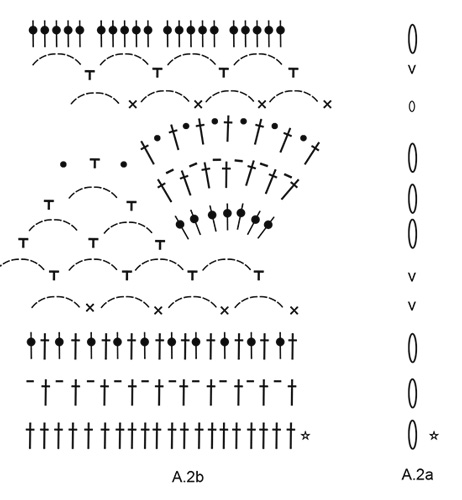
|
||||||||||||||||||||||||||||||||||||||||||||||
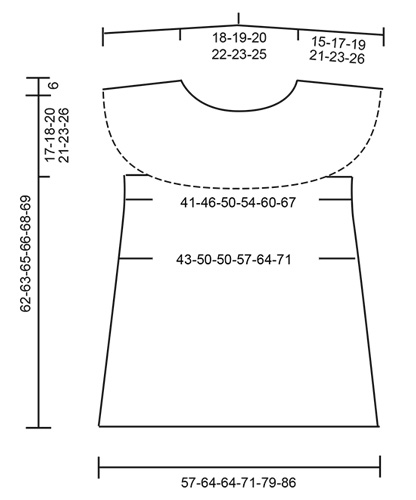
|
||||||||||||||||||||||||||||||||||||||||||||||
|
Have you made this or any other of our designs? Tag your pictures in social media with #dropsdesign so we can see them! Do you need help with this pattern?You'll find tutorial videos, a Comments/Questions area and more by visiting the pattern on garnstudio.com. © 1982-2024 DROPS Design A/S. We reserve all rights. This document, including all its sub-sections, has copyrights. Read more about what you can do with our patterns at the bottom of each pattern on our site. |
||||||||||||||||||||||||||||||||||||||||||||||





























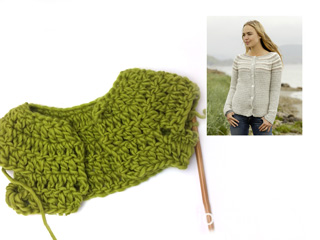





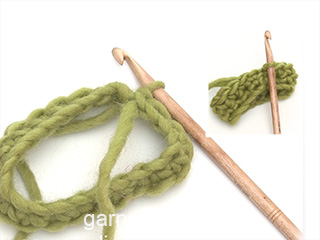

















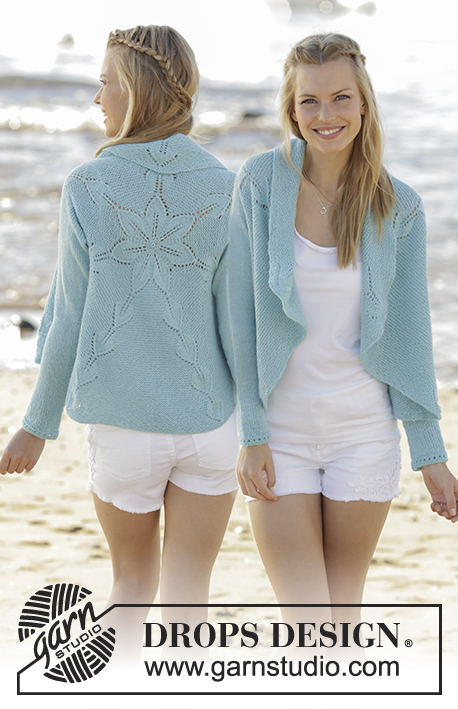

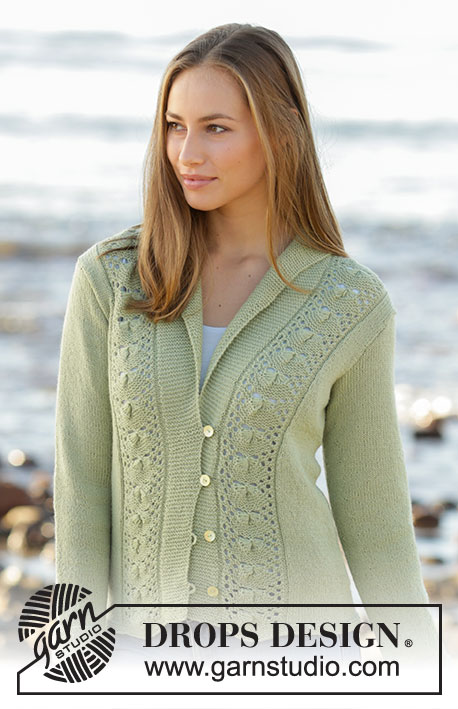






Comments / Questions (53)
¿Por qué se inicia con 115 cadenas si se trabajan 96 puntos altos en la primera vuelta?
01.10.2019 - 20:58DROPS Design answered:
Hola Alejandra. A menudo en las labores a ganchillo la cadeneta de montaje tiene más puntos que la labor principal, eso permite evitar que el borde de montaje quede tenso.
01.10.2019 - 22:43I'm working on the body, and it says to cut the yarn and skip some stitches and fasten with a sc, then begin 2nd round on the diagram. My question is do I start round one in the same stitch as the sc, or the next one?
23.07.2019 - 00:28DROPS Design answered:
Dear Jennifer, the rounds start now with the stitch where you worked the sc, just continue working A.2a from the stitch where you joined the yarn, the repeat A.2b in the round from next stitch. Happy crocheting!
06.08.2019 - 09:38Grata pela resposta, mas a pergunta não é sobre o que é um ponto alto, mas sim o que quer dizer: (...)em cada um dos 3-0-0-0-0-3 pontos corrente seguintes, *saltar 1 ponto corrente, 1 ponto alto duplo em cada um dos 5 pontos corrente seguintes*, repetir de * a * mais 15-16-17-18-19-19 vezes = 84-86-91-96-101-104 pontos altos duplos. Obrigada
05.06.2019 - 19:53DROPS Design answered:
Bom dia, Não compreendemos a sua dúvida... Deve fazer o ponto alto duplo como indicado. entre os asteriscos (*). Depois, repete o que fez mais o número de vezes indicado para o seu tamanho. Esperamos tê-la ajudado com a resposta! Bom Croché!
11.06.2019 - 13:06Boa noite, Não consigo interpretar as explicações para iniciar o meu modelo que adoro É a primeira vez. Podem explicar o que quer dizer o (: Um ponto alto duplo em cada um dos 3-0-0-0-0-3. O modelo é W-623. Muito obrigada.
31.05.2019 - 23:01DROPS Design answered:
Bom dia, Um ponto alto duplo é um ponto alto em que se fazem mais laçadas para ficar mais alto. Pode ver nas explicações, por baixo da foto, todos os vídeos que a ajudam a fazer este bonito modelo. Aqui fica o link do vídeo que mostra como fazer 1 ponto alto duplo: https://www.garnstudio.com/video.php?id=28&lang=pt Bom croché!
04.06.2019 - 11:05How many balls of wool does this require?
07.04.2019 - 19:10DROPS Design answered:
Dear Zara, depending on the size you want to make, this piece needs between 9-14 piece of 50 gramms balls of DROPS Paris yarn. Happy Crafting!
07.04.2019 - 19:42Ik de beschrijving staat in de 2de toer haak 1 dubbel stokje in elk van de volgende 3-0-0-0-0-3 lossen, * sla 1 losse over, haak 1 dubbel stokje in elk van de volgende 5 lossen *, wat wordt er bedoeld met 3-0-0-0-0-3? Graag uw hulpm
03.04.2019 - 16:49DROPS Design answered:
Dag Joyce,
De reeks getallen met streepjes ertussen slaan op de maten; dus 3 is voor maat S, 0 is voor maat M, enzovoort.
04.04.2019 - 08:08I am confused about the "double double" crochet stitch as listed in the yoke section. Can you please describe how to do this stitch?
03.04.2019 - 03:09DROPS Design answered:
Dear Amy! I think you mean 'double treble crochet'. Please see the video: HERE. Happy crocheting!
05.04.2019 - 19:00Diagram och skiss saknas på svenska
29.03.2019 - 10:10Hei. Jeg får ikke maskeantallet til å stemme med økningene på bærestykket. Det står at jeg, i str. M skal ha 220 masker når jeg er ferdig med økningene men jeg har bare 216. Det står at jeg skal øke over de 40 maskene i hver side, på 2. og 5. omg 34 masker og 36 masker på 6.-8. omg. 40+34+34+36+36+36 er 216 masker. Jeg vil da få for lite masker da jeg skal dele inn i bol og ermer. Hva er det jeg ikke har fått med meg?
27.03.2019 - 13:18DROPS Design answered:
Hei Monica. Her var det en feil i maskeantallet: Du øker 17 masker i hver side (totalt 34 masker) på omgang 2 og 5, og du øker 18 masker i hver side (totalt 36 masker) på omgang 8. Dette er nå blitt rettet i oppskriften. Du vil da ha de 116 maskene fra før + 34 + 34 + 36 = 220. God fornøyelse
03.04.2019 - 09:32Hej Var finns diagrammet till detta mönster? Hälsningar Nadja Brolin
14.03.2019 - 19:30DROPS Design answered:
Hej. Du hittar det längst ner på sidan, precis över måttskissen. Lycka till!
18.03.2019 - 10:32